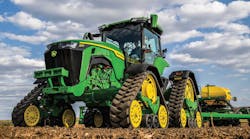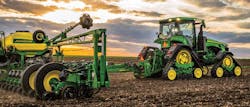Throughout history, farmers have looked for more efficient and effective ways to improve their craft. Starting with the advent of the tractor over 100 years ago, productivity on the farm has only grown to be more technologically advanced, allowing farmers to complete more tasks with less available resources.
Today, farmers continue to have the responsibility of feeding a growing world population while overcoming challenges like the decline of arable farmland, a shrinking labor pool and unpredictable weather conditions. Given this, the agriculture industry has found it critical to maximize on the automation of tasks that require extreme precision and consistency so farmers can spend more time managing other important jobs related to their operation.
This level of resilience is a force to be reckoned with, and every industry from healthcare to retail to construction and beyond can glean insights on how sensor technology, computer vision and robotics are driving automation on the farm to increase efficiency, profitability and sustainability for generations to come.
Sensor Technology
Generations of the same family often farm the land for years and, in the process, record each season’s successes and failures. The repetitive nature of this data and documentation makes the farmer the most important sensor on the farm, though the task of record-keeping has only gotten more streamlined with the availability of advanced technology.
With increasingly complex decisions needing to be made, it’s helpful for a farmer to have highly automated machines that can understand historical data and pair it with real-time data to determine what’s needed in the moment. Sensor technology adds to the farmer’s intuition and experience by enabling machines moving throughout the field to understand what’s happening and compare it to years past for the best possible outcome.
For example, sensors on a planter allow the machine to calculate where to place a single seed into the soil. Sensors ensure each seed is placed one-by-one in the ground, perfectly spaced at the right depth and the right distance from one to another, while recording if something goes wrong. While doing this, the sensors are also informing the planter when to automatically adjust the pressure of each individual robot in charge of placing seeds when transitioning between different soil types in the field, such as from sand to soil.
Computer Vision for Observation
Observation is critical for any worker in any industry. In agriculture, observation can help a farmer make important, timely decisions—but the human eye can only see so far.
With computer vision, farmers gather data from places where they wouldn’t typically have the ability to go, such as inside a combine, the massive “factory on wheels” that harvests grain when crops are ready. During harvest, grain must be separated from the rest of the plant and a farmer’s goal is to make that happen with as little damage as possible to the kernel. This used to happen manually, with a farmer routinely reviewing a handful of harvested kernel samples to know when and how to adjust settings.
Now, sensors and computer vision technology in the grain tank can register how much grain is coming off the plants, whether the grains are broken and whether there is any material other than grain also getting through, all in real-time. If the conditions aren’t optimal the combine uses machine learning to understand what’s wrong and automatically acts to adjust the combine’s settings to achieve more favorable results.
Robotics for Precision
Farming is a year-round job that requires precision at all stages of the growing cycle. As operations can typically be physically taxing and highly repetitive over the course of many hours, robotics are used to take unnecessary burdens off of the farmer while still supporting their productivity and quality goals.
With robotic technologies, farmers can automate tasks and execute at the plant level with great precision. As machines plant seeds, apply nutrients and harvest crops, there are a lot of robotics at play to do so. This is especially helpful when there are thousands of acres of farmable land, which can be home to hundreds of millions of plants.
For example, after planting and before harvest, a farmer will use a sprayer, another advanced machine, to apply crop protection and nutrients to their plants. Weather conditions like temperature, humidity and wind speed all impact a farmer’s ability to spray where and what’s needed. Advanced robotics built into the machines enable a farmer to control the amount of nutrients sprayed, droplet size and even distance from the plants by automatically adjusting the volume, pressure and height of the boom, which is attached to the sprayer and can measure up to 120 feet wide with nearly 100 different spray nozzles.
Advanced Technologies for Tomorrow
Farmers have always been at the forefront of solving problems with hard work and innovation. When paired with advanced technology like sensors, computer vision and robotics, farmers have the tools necessary to maintain their business and grow quality food for the world.
Advanced technology’s contribution to agriculture is especially impactful today as, according to the United Nations, the world’s population is expected to grow to nearly 10 billion by 2050, increasing global food demand by 50%.
The sky is the limit in terms of how farmers will continue to embrace technology in the future—and it’s something that every industry can learn from.
Jesse Haecker is business manager for Planting, Spraying and Nutrient Application at John Deere.

